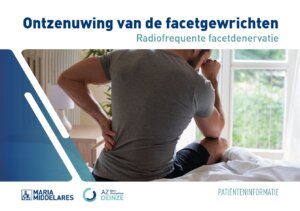Facet joint denervation
What is it?
What is it?In order to confirm that the facet joints contribute to your pain, a test block (e.g. diagnostic block) is first performed at the level of the joints. A positive block is used as an indication, but is not an absolute guarantee that radiofrequency denervation will be successful. It is necessary to first do this, however, so that the facet denervation will be reimbursed.
Due to wear and tear (arthrosis), inflammation, an operation or an accident, there can be changes to the facet joints (mobile connections between the vertebrae). When this happens, the joints can become irritated and then cause pain in the neck, chest or lumbar area.
A ‘denervation’ of the facet joints can be useful in this case. Using a radiofrequency current, the relevant nerve branch is heated. This heat affects the nerve and blocks the pain signals that travel along the nerve pathways of the facet joints towards the brain. With the (temporary) denervation, the pain can be reduced for a longer period.
A test block and a facet denervation cannot be performed on the same day. Denervation can be performed during the first three months after a positive test treatment.
Treatment procedure
Treatment procedurePreparation
Come to the hospital on the day of treatment. You do not have to fast for the treatment. You may eat and drink.
By law, you may not drive any vehicles or operate machinery the morning after the treatment. Therefore, make sure that somebody can take you to and from the hospital. The physician or nurses can provide you with certificates, if required. If you wish, the nurses of the Pain Centre can order a taxi for you.
Always inform the physician if:
- you have diabetes or a heart condition
- you are (or could be) pregnant
- you are allergic to certain medications, contrast agents or iodine (disinfectant), latex, etcetera
- you take blood thinners
If you have reduced kidney function, have recently experienced thrombosis or a heart attack or have had a stent implanted, you must contact your attending physician first.
| Medication | Stop | Comments |
|---|---|---|
| Asaflow®, Aspegic® Cardioaspirin®, Aspirin® Dispirl®, Sedergin® | Stop if >500 mg/day | |
| Marcoumar®, Sintrom® Marevan® | Seven days before the procedure | Replace with injections (see Clexane, for example) Anticoagulation before the procedure |
| Ticlid® | ten days before the procedure | |
| Plavix®, Clopidogrel Brilique®, Efient® | Seven days before the procedure | |
| Xarelto®, Eliquis® Lixiana®, Pradaxa® | 48 hours before the procedure | |
| Fraxiparin®, Clexane® Fraxodi® | 24 hours before the procedure |
|
Leaflet
LeafletYou can find more information in the leaflet at the bottom of the page.
- the test block process
- course of the admission and the treatment
- the possible side effects and complications
Only available in Dutch:

Ontzenuwing van de facetgewrichten
DownloadCost estimate
Cost estimateCentres and specialist areas
Centres and specialist areas
Latest publication date: 19/08/2024
Supervising author: Dr Decaigny Veronique



